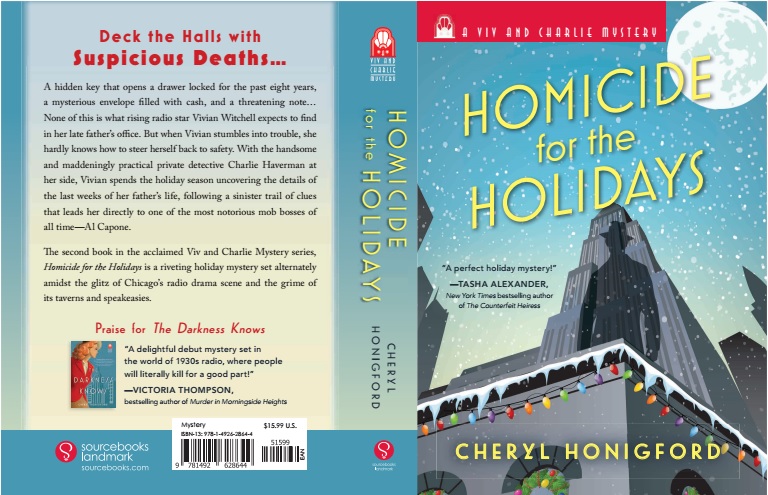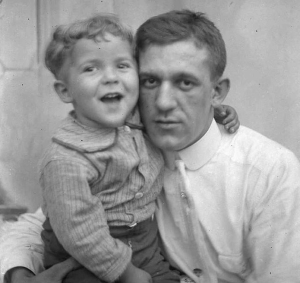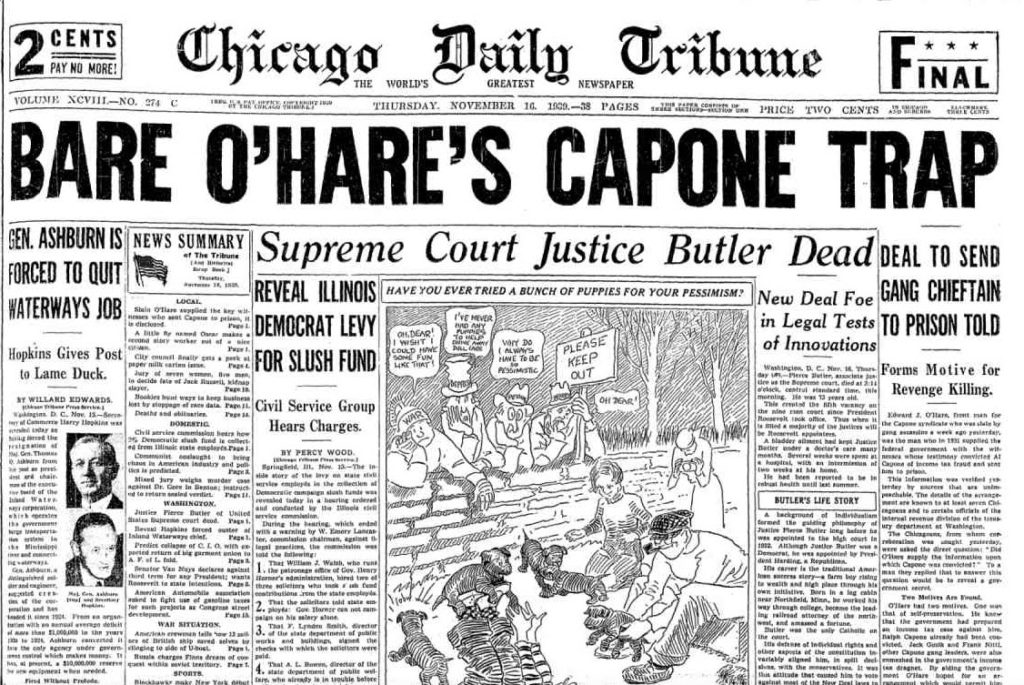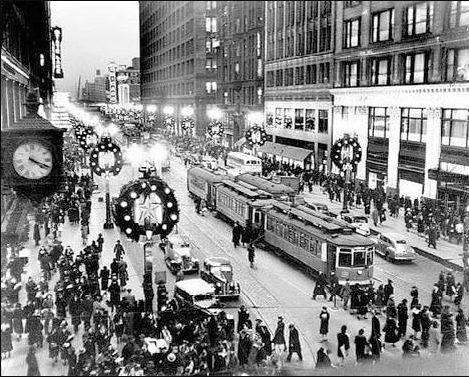Homicide for the Holidays – Final Cover!

She’s so pretty (and available for pre-order)!

She’s so pretty (and available for pre-order)!
You may know that Chicago’s O’Hare Airport is named for WWII flying ace Butch O’Hare who was shot down over the Pacific in 1943. What you may not know is that the only reason Butch became a pilot at all was because of his father – lawyer, crook, and known associate of Al Capone.

Edward (Easy Eddie) O’Hare was never the most upstanding of lawyers. He bamboozled a client’s widow out of the patent to those mechanical rabbits that greyhounds chase around the racetrack.
That’s how he made his fortune, and that’s how he met Al Capone. Capone owned a greyhound track outside Chicago. They eventually became associates and business partners (and the greyhound track was turned into Sportsman’s Park for horse racing. Conveniently, Eddie became its president).
Needless to say, the 1920s were a high time for Easy Eddie, that is until the apple of his eye, his eldest son Edward Jr (known as Butch), told Eddie that he wanted to attend the Naval Academy in Annapolis, MD and become a pilot. Eddie could deny his boy nothing. The problem was that the sitting local congressman needed to nominate Butch to attend the academy, and no congressman in his right mind would nominate the son of a known Capone associate. Not even in Chicago.
What was a father to do? Well, Eddie decided he needed to change his ways. Through a journalist intermediary, he made it clear to the Feds he would give them info on Capone’s organization if they helped him get his son into the Naval Academy. He did – and they did. Butch went to the academy and eventually became a fighter pilot and hero over the Pacific, but Eddie wouldn’t live long enough to witness that. Eddie was gunned down while driving his Lincoln on Ogden Avenue in November 1939. His murder remains technically unsolved, but it’s pretty safe to assume that his double-crossing of The Outfit finally caught up to him.

I’m telling you all of this, because it’s a fascinating story, but also because Easy Eddie O’Hare was the inspiration for Viv’s father, “Easy Artie” Witchell, in HOMICIDE FOR THE HOLIDAYS.
If you’ve read The Darkness Knows you’ll know that Vivian is a daughter of privilege. You’ll see even more evidence of that in the second book in the series, Homicide for the Holidays. You’ll also learn that Vivian’s mother, Julia Witchell, is the youngest daughter of a Chicago meatpacking scion (and what could be more late 19th/early 20th century Chicago than a meatpacking dynasty? (But that’s another rabbit hole topic).
Vivian’s mother had wanted her to “come out” on her 18th birthday just as she had. However, times had changed since Julia’s 18th birthday in 1907 and Vivian’s in 1932. Times had changed drastically.
WWI (or The Great War as they called it at the time) happened ushering in the flapper era of the 1920s. Women coming of age in the 1920s (like Vivian) experienced a good deal more freedom than their mothers had. It became acceptable for women to smoke and drink in public, for example, and for single women to have jobs outside the home. Then the stock market crashed in October 1929 throwing the country and world into The Great Depression. There were still wealthy families in the US (the Witchells remained well off during this period), but the vast majority were struggling. Overt expressions of wealth displayed in lavish coming out parties were viewed as more than a little tone deaf – as young Woolworth heiress, Barbara Hutton, found out when she came out in November of 1930.
Her party was held at the Ritz Carlton, and she was skewered in the press for spending $50,000 on flowers alone. Invitees included stars Maurice Chevalier and Rudy Vallee. Other guests included society bigshots with names like Vanderbilt, Astor, and Rockefeller.

She looks ecstatic, doesn’t she?
Barbara Hutton became known as “The Poor Little Rich Girl” (and “Rich Bitch” to some) and went on to marry 7 times – all unhappily. Among her husbands were a Danish count, a Russian prince, and Cary Grant. Yes, that Cary Grant (and there’s another rabbit hole…)
All of this to say, that Vivian was staunchly against having her own coming out party. I found this Chicago Tribune article from 1974 that articulates Vivian’s feelings on the matter perfectly. Vivian never did have one – and to find out why you’ll have to read Homicide for the Holidays.
One of the things that surprised me when I started researching Chicago in the 1930s was the ubiquity of streetcars They’ve disappeared from the city entirely since – gradually phased out by buses during the 1950s.

That’s a photo of streetcars operating on State Street at Christmastime in the late 1930s/early 1940s. You can see that the passengers waited and boarded from that island-like space in the middle of the north and southbound lanes. Seems awfully dangerous to me and judging from this silent safety film from the early 1930s… it was.
Vivian rides the streetcar several times in the first two books in the series – mostly in book two. A one-way trip cost 7 cents in 1938. Oncoming passengers entered from the back and paid cash to ride – the conductor at the back wore a change belt. The seats inside were rattan and the interior was sparsely heated and I imagine it was terribly drafty in the winter and incredibly stuffy in the summer. The driver often shoved papers between the bell and the clacker above his head to mute the constant dinging on the inside of the car (and save his sanity, I assume). I found a great first-hand account of riding a Chicago streetcar of this period in an old edition of Nostalgia Digest. You can read it here if you like: Streetcar Info.
So here it is – the cover for Book #2 in the Viv and Charlie Mystery Series, HOMICIDE FOR THE HOLIDAYS! As you can see, the Sourcebooks marketing/art department has gone for more of a cozy mystery feel and really played up the Christmas setting of the book. A lot of reader comments that Sourcebooks and I have gotten about THE DARKNESS KNOWS have been along the lines of “cozy” and “fun” (which is exactly what I intended it to be!), so Sourcebooks wanted the cover of the second book to reflect that feedback a little more.
Before you ask, no, I don’t have any input on the cover. 🙂 I saw it myself for the first time last week, but I do get to tell them whether I like it or not. (I do.) What do you guys think?
The actual physical ARCs (advanced reader copies) of HOMICIDE FOR THE HOLIDAYS should be available in the next 2-3 weeks for review purposes.
It’s also available on Amazon for pre-order.
How could a mystery series that takes place in 1930s Chicago not at least make one reference (or ten) to that town’s infamous reputation from Prohibition? Prohibition and you-know-who* do come into play in Book #2 of the Viv and Charlie Mystery Series, and as usual, I found myself spending a lot of time trolling the archives of The Chicago Tribune for research.
I ran across a series of retrospective articles that ran in early 1951 written by veteran reporter Jim Doherty**. He was a reporter with The Tribune during Prohibition, and in 1951 was reminiscing about events only about 20 years in the past for him. That’s a veritable gold mine for a historical fiction author (or just a history nerd that enjoys squinting at old newspapers, like myself). I thought I’d share them here, because these articles don’t seem to exist in a collected form (or anywhere else for that matter).
Booze, Bootleggers, and Bullets (Feb 4, 1951)
The First Dry Law Raids (Feb 11, 1951)
The $100,000 Hi-Jacking (Feb 18, 1951)
The Shooting of Dion O’Banion (Feb 25, 1951)
Texas Guinan Queen of Whoopee (March 4, 1951)
Portrait of a Gangster Ted Newberry (March 11, 1951)
Life for a Pint (March 18, 1951)
“Here’s How!” in the Goats’ Nest! (March 25, 1951)
*Al Capone King of the Hoodlums (April 1, 1951)
*How Capone Ruled Chicago (April 8, 1951)
*Curtains for Capone! (April 15, 1951)
Big Bill Thompson (April 29, 1951)
End of an Era: The Last Days of Big Bill (May 6, 1951)
**About the Author – From the very first article in the series (Feb 4, 1951)
James Doherty became a newspaper reporter in 1919, shortly after he left the army. Following an apprenticeship of six weeks as a reporter for the City News bureau, he joined the staff of The Tribune. He was soon in the midst of a fabulous reportorial career, which he will describe in this series of articles. Before entering the army, “Jim” Doherty had been deputy clerk of the Juvenile court and deputy clerk of the Criminal court and he had been an aldermanic candidate. His father was a police lieutenant and acting captain. Jim has five brothers, all newspapermen. Jim Doherty has specialized on reporting crime and politics for The Tribune. He helped to form the Crime Prevention bureau, a cooperative unit of several law enforcement group. He is a bachelor.
(He died in 1961.)
I thought I’d share a little about Book 2 in the Viv and Charlie Mystery Series, since I’ve been asked about it a lot recently. (It’s great to hear that people are excited for #2, by the way!). DISTURB NOT THE DEAD, comes out in October 2017. It’s set about two months after the events of the first book – at Christmastime 1938. Vivian stumbles upon something that flips everything she thought she knew about her beloved (and now deceased) father on its head. Expect more radio station intrigue (especially with Vivian’s star on the rise) and more historic Chicago detail woven throughout. And of course, Charlie is roped in to help Vivian get to the bottom of everything.
I was just told last week that Sourcebooks is working on the cover for #2 as we speak (using the same fabulous artist that created the cover for THE DARKNESS KNOWS, Coco Masuda). I can’t wait to see it! (And as soon as I see it I’ll be sure to share it here with all of you!)
The first chapter of DISTURB NOT THE DEAD actually appears at the end of THE DARKNESS KNOWS and opens on Vivian lackadaisically decorating the Christmas tree with her younger brother, Everett. Check there for a teaser of what’s in store for Vivian (and Charlie and Graham and everyone else)… and here’s the first paragraph of the book’s synopsis. (To share any more of it would give the story away, and I wouldn’t want to do that!)
Rising radio star, VIVIAN WITCHELL, finds an envelope of cash and a threatening note in her dead father’s desk during the family Christmas party. Arthur Witchell, once a prominent Chicago attorney, has been dead for almost eight years. But something tells Vivian there’s something to this discovery and more to her father than she’d thought possible – especially when the money and the note disappear from the locked desk drawer. Someone had been threatening her father’s life shortly before he died, and someone wants to stop Vivian from finding out about that threat now.
You can follow my Pinterest board for DISTURB NOT THE DEAD if you’d like a little peak into the inspiration behind the story including 30s fashions, vintage Chicago photos, and popular music of the period. It was so fun “visiting” Chicago at Christmas in 1938. I also have a relatively new Instagram account where I’ve started sharing ephemera from my (alarming large) collection of vintage magazines.